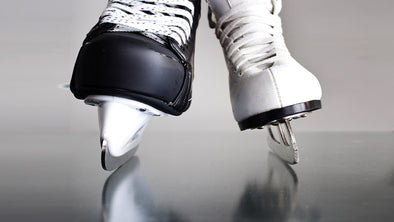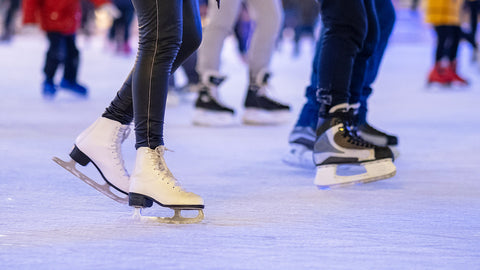Ice skates are designed primarily for figure skating and leisure skating, with a focus on gliding and maneuverability, while hockey skates are specifically designed for ice hockey, with a focus on speed, agility, and stability during quick turns and stops. Ice skates and hockey skates are designed to meet the specific needs of figure skaters and ice hockey players respectively.
Ice skates facilitate graceful and precise movements on the ice, allowing figure skaters to perform intricate jumps, spins, and dance-like routines. On the other hand, hockey skates are designed for quick acceleration, sharp turns, and sudden stops, as well as providing support and protection during physical play on the ice.
Whether you are gliding elegantly or racing on the ice, the type of skates you choose will greatly impact your performance and experience. Understanding the differences between ice skates and hockey skates is key to selecting the right pair for your chosen activity.

Credit: www.polyglidesyntheticice.com
Table of Contents
- 1 History Of Ice Skates
- 2 History Of Hockey Skates
- 3 Design Variances
- 4 Performance Differences
- 5 Safety Features
- 6 Usage Variations
- 7 Fit And Comfort
- 8 Maintenance Variation
- 9 Price Range
- 10 Brand Preferences
- 11 User Considerations
- 12 Frequently Asked Questions Of What Is The Difference Between Ice Skates And Hockey Skates
- 12.1 What Are The Main Differences Between Ice Skates And Hockey Skates?
- 12.2 Can I Use Ice Skates For Playing Hockey And Vice Versa?
- 12.3 How Do The Blades Of Ice Skates And Hockey Skates Differ?
- 12.4 Are The Boots Of Ice Skates And Hockey Skates Similar?
- 12.5 Which Type Of Skates Are Suitable For Beginners In Skating?
- 12.6 Are There Any Specific Safety Considerations For Ice Skates And Hockey Skates?
- 12.7 Can Ice Skates And Hockey Skates Be Used Interchangeably For Recreational Skating?
- 13 Conclusion
History Of Ice Skates
The History of Ice Skates dates back to ancient times, with early models carved from bone or wood.
Evolution Of Ice Skates
Ice skates have evolved over the centuries, transitioning from simple designs to more advanced configurations.
Notable Innovations
Several key innovations have shaped the modern ice skate, leading to improved performance and comfort for users.
History Of Hockey Skates
The history of hockey skates dates back to the early 19th century when ice hockey started gaining popularity as a sport. Initially, hockey players wore regular ice skates commonly used for recreational purposes. However, as the game became more competitive and demanding, it required specialized skates designed specifically for the sport.
Development Of Hockey Skates
The development of hockey skates began with the need to enhance players’ speed, maneuverability, and overall performance on the ice. Innovations in skate design aimed to provide better stability, control, and protection during intense gameplay.
Technological Advancements
In recent years, the advancements in skate technology have revolutionized the game of hockey. Manufacturers have introduced various features and improvements to enhance skates’ performance and players’ comfort.
Some notable technological advancements in hockey skates include:
- Lightweight Materials: The use of lightweight materials such as carbon fiber and advanced composites has allowed skates to be lighter, improving players’ speed and agility.
- Blade Technology: The introduction of advanced blade systems with better edging, enhanced grip, and quick change options have significantly improved maneuverability and overall skating performance.
- Custom Fit: Many skate models now offer customizable features such as heat-moldable boots and adjustable parts, ensuring a personalized fit for each player.
- Shock Absorption: Enhanced padding and shock-absorbing materials in the boots provide added comfort and protection against impacts and vibrations.
- Aerodynamic Design: Skates now feature streamlined and aerodynamic designs to reduce drag and improve skating efficiency.
| Ice Skates | Hockey Skates |
|---|---|
| Generally used for recreational ice skating or figure skating. | Specifically designed for playing ice hockey, focusing on performance and durability. |
| Have longer blades for stability and controlled gliding. | Shorter blades for increased maneuverability and quick turns. |
| May have toe picks for tricks and jumps in figure skating. | No toe picks as they can interfere with quick movements and quick stops in hockey. |
| Lack protection features necessary for contact sport like hockey. | Provide additional ankle support, padding, and reinforced toe caps for player safety during physical gameplay. |
Overall, while ice skates and hockey skates share a similar foundation, their design and purpose vary significantly. Ice skates prioritize stability and graceful gliding for recreational use and figure skating, while hockey skates prioritize speed, maneuverability, and player safety to excel in the fast-paced, physical game of ice hockey.
Design Variances
Design variances between ice skates and hockey skates play a crucial role in differentiating the two. Understanding these differences can help in choosing the right type of skates for specific activities. Below we will examine the various design discrepancies, focusing on blade shape and boot structure.
Blade Shape
The blade shape is one of the key distinctions between ice skates and hockey skates. Ice skates typically feature a long, straight blade with a single edge. On the other hand, hockey skates have shorter, more curved blades with two edges. The purpose of these variations lies in the different requirements of each activity. Ice skates are designed for graceful and fluid movements, necessitating a longer and straighter blade to facilitate gliding and turns. Conversely, hockey skates demand quick movements and maneuverability, hence the shorter, curved blades that enable swift directional changes and agility on the ice.
Boot Structure
Another noticeable difference between ice skates and hockey skates lies in the construction of the boot. Ice skates often feature a higher cut and more rigid boot, providing ankle support to enhance stability and control during figure skating routines. In contrast, hockey skates are designed for speed and acceleration, with lower-cut and more flexible boots that enable players to move swiftly and make quick, sharp turns on the ice. The design variances in the boot structure reflect the distinct performance requirements of each activity.

Credit: www.polyglidesyntheticice.com
Performance Differences
Ice skates and hockey skates may look similar, but there are distinctive differences in their performance. Each type of skate is designed to cater to the specific demands of the activity it is intended for, be it precision figure skating or fast-paced hockey. Understanding these differences can help you choose the right option for your needs.
Maneuverability
- Ice Skates: Designed for smooth and elegant movements, ice skates prioritize maneuverability. The blade’s toe picks allow for precise control and effortless turns, enabling figure skaters to perform intricate routines with grace.
- Hockey Skates: Emphasizing agility and quick directional changes, hockey skates have a more aggressive blade profile. The lack of toe picks enables players to swiftly maneuver around the rink, essential in the fast-paced game of hockey.
Speed Capacity
- Ice Skates: While ice skates focus on precise movements, they are not optimized for maximum speed. The design prioritizes stability and control, essential for executing jumps and spins rather than high velocity.
- Hockey Skates: Built for speed, hockey skates emphasize acceleration and top-end velocity. The blade design and shorter blade length allow players to reach high speeds, facilitating quick shifts and breakaways during gameplay.
Safety Features
Ice skates and hockey skates may appear similar, but they have distinct safety features designed for specific purposes.
Ankle Support
Ankle support is crucial for both ice and hockey skates to prevent injuries during rapid movements on the ice.
Impact Resistance
Impact resistance in hockey skates is typically higher due to the physical nature of the sport compared to ice skating.
Usage Variations
Ice skates and hockey skates differ in blade design and ankle support, with hockey skates having a shorter, more curved blade for quick turns and stops, while ice skates have a longer, flatter blade for graceful gliding. Additionally, hockey skates offer more protection for the foot and ankle to endure physical play on the ice.
Ice skates and hockey skates may appear similar at first glance, but they serve different purposes when it comes to usage. Understanding the variations between the two can greatly impact your skating experience. In this section, we will explore the differences in targeted activities and suitability for different surfaces.
Targeted Activities
Ice skates and hockey skates are designed with specific activities in mind. Ice skates are primarily used for figure skating and recreational ice skating. These skates feature a longer blade with a flat profile, allowing for better gliding and graceful movements on the ice. Their design prioritizes gracefulness, precision, and artistic maneuvers. On the other hand, hockey skates are tailored for the fast-paced and physically demanding sport of hockey. They are built with shorter blades and a more curved profile, enabling quick turns, acceleration, and agility on the ice. The focus of hockey skates is on speed, quick changes in direction, and enhanced maneuverability necessary for game play.
Suitability For Different Surfaces
Ice skates and hockey skates also differ in their suitability for various surfaces. Ice skates excel on well-maintained indoor and outdoor ice rinks. Their longer blades aid in gliding smoothly on the ice and achieving the desired level of control necessary for figure skating and precise movements. Alternatively, hockey skates are designed to perform optimally on the ice used for hockey games. These skates can handle rougher surfaces, such as frozen ponds or outdoor rinks with slight imperfections. The shorter blades and curved profile make it easier to navigate through the faster and more aggressive movements required in hockey. In summary, understanding the divergence between ice skates and hockey skates is crucial in selecting the appropriate footwear for your intended activity. Ice skates are ideal for figure skating and recreational ice skating, offering elegance and precision, while hockey skates are specialized for the rapid movements, quick turns, and agility required in hockey games. Additionally, ice skates are better suited for well-maintained ice rinks, whereas hockey skates are designed to handle rougher surfaces encountered in the sport. Choose wisely, and enhance your skating experience accordingly.
Fit And Comfort
Ice skates and hockey skates differ in fit and comfort. Understanding the key distinctions can help you choose the right pair for your needs.
Fit Adjustment Options
Fit adjustment options allow skaters to customize how snugly their skates fit.
- Lace-up design for personalized fit.
- Boa closure system, which offers micro-adjustability.
Padding And Support
Padding and support play a crucial role in ensuring comfort and performance on the ice.
- Thick padding for added comfort and impact absorption.
- Ankle support to prevent injuries and maintain stability.

Credit: summitcitysports.com
Maintenance Variation
Ice skates and hockey skates differ in their maintenance needs. Ice skates are designed for figure skating and require sharp edges, while hockey skates need frequent blade sharpening due to the rough nature of the sport. The maintenance variation between the two types of skates lies in their specific usage and performance demands.
Maintenance Variation When it comes to ice skating, proper maintenance of your skates is essential to ensure optimal performance and longevity. While both ice skates and hockey skates require regular maintenance, there are some key differences in their sharpening needs and care instructions. H3: Sharpening Needs Ice skates and hockey skates have different blade designs and cutting edges, resulting in varying sharpening needs. Ice skates typically feature a single, long blade with a gradual curve, while hockey skates have shorter blades with a more pronounced curve. This design difference is reflected in the sharpening technique required for each type of skate. For ice skates, a figure skater may prefer a shallow hollow grind, which provides stability and control while executing precise maneuvers on the ice. On the other hand, hockey players often opt for a deeper hollow grind, enhancing their ability to make quick turns and stops during fast-paced gameplay. H3: Care Instructions Proper care and maintenance of your skates is vital to prolong their lifespan and ensure excellent performance on the ice. Below are the care instructions for both ice skates and hockey skates: For ice skates: 1. After each use, wipe off any excess moisture with a dry cloth to prevent rust. 2. Inspect the blades for any nicks or damages and have them professionally repaired if necessary. 3. Store your ice skates in a dry environment, preferably in a skate bag or with blade covers to protect them. For hockey skates: 1. Similarly, wipe off any excess moisture after each use to prevent corrosion. 2. Check the blade holders and rivets for any loose screws and tighten them if needed. 3. Sharpen your hockey skates regularly, taking into consideration your playing style and preferences. 4. Store your skates in a well-ventilated area to dry completely and avoid unpleasant odors. Remember, proper maintenance is not only crucial for the performance of your skates but also for your safety on the ice. Take the time to care for your skates, and they will serve you well throughout your ice skating journey. In conclusion, ice skates and hockey skates have differing sharpening needs and care instructions due to their varying designs and intended usage. By understanding and following the maintenance guidelines specific to each type of skate, you can optimize their performance and extend their lifespan. So, whether you’re a figure skater or a hockey player, make sure to give your skates the attention they deserve.
Price Range
Ice skates and hockey skates can vary in price due to several factors, including their specific design features and performance capabilities. Understanding these differences can help you make an informed decision when considering a purchase. In this section, we will explore how the price range for ice skates and hockey skates can be affected and compare their value for money.
Factors Affecting Cost
The cost of ice skates and hockey skates is influenced by several key factors such as materials, construction, brand reputation, and technological innovations. High-quality materials and advanced manufacturing processes can contribute to a higher price tag, as can the inclusion of specialized features tailored to the demands of ice sports. Additionally, well-established brands with a strong track record in the industry may command a premium for their products, reflecting their reputation for delivering performance and durability. Newer technological advancements, such as lightweight and impact-resistant materials, can also impact the pricing of skates due to their cutting-edge design and enhanced performance characteristics.
Value For Money Comparison
When evaluating the value for money offered by ice skates and hockey skates, it’s essential to consider the specific needs and preferences of the user. For leisure or recreational skaters, a more affordable option that still provides adequate support and comfort may offer the best value. On the other hand, competitive athletes or dedicated players may prioritize performance and durability, making a higher-priced, premium model a worthwhile investment. By carefully assessing the features and benefits offered by different skates in relation to their respective price points, individuals can make an informed decision that aligns with their budget and performance expectations.
“`
Brand Preferences
Brand preferences play a significant role in the choice between ice skates and hockey skates. Both types of skates have their own set of popular brands, each offering distinct features and benefits. Understanding the preferences and differences between these brands can help you make an informed decision when choosing the right pair of skates for your needs.
Popular Ice Skate Brands
When it comes to ice skates, there are several renowned brands that consistently deliver high-quality products. Bauer, Jackson Ultima, and Riedell are among the most popular and trusted brands in the ice skating community. These brands are known for their innovative technology, superior craftsmanship, and comfortable fit, making them top choices for figure skaters, recreational skaters, and competitive athletes alike.
Top Hockey Skate Brands
If hockey is your sport of choice, you have a variety of top-notch brands to consider when it comes to hockey skates. CCM, Bauer, and Graf are well-regarded brands in the hockey world, offering durable construction, advanced performance features, and customizable options to meet the specific needs of hockey players at every level of the game.
User Considerations
When deciding between ice skates and hockey skates, there are several user considerations that can help you make the right choice. Depending on your skill level, intent, and personal preferences, different factors come into play. In this section, we will provide Beginner Guidance and Professional Player Insights to help you understand the key distinctions between these two types of skates.
Beginner Guidance
If you are a beginner or just starting out with ice skating, it is important to choose the right skates that support your learning process. Here are a few factors to consider:
- Boot Style: Both ice skates and hockey skates have different boot styles. Ice skates typically have a higher boot that offers more ankle support, making them ideal for beginners who need stability while they learn to balance on the ice.
- Blade Design: The blade design is another crucial consideration for beginners. Ice skates have longer and flatter blades, allowing for better control and stability. On the other hand, hockey skates have shorter, curved blades which enable quick turns and maneuvers on the ice.
- Padding and Comfort: Comfort is key when it comes to beginner skates. Ice skates often come with more padding around the ankle and tongue, providing additional cushioning and support. Hockey skates, on the other hand, focus more on performance and may have less padding, prioritizing responsiveness and agility.
Professional Player Insights
If you are a professional or an experienced ice skater, there are certain factors that become crucial in your skate selection process. Consider the following insights:
- Performance and Speed: For professional players, speed and performance are often top priorities. Hockey skates are specially designed for quick movements, power, and speed on the ice. They have shorter blades that allow players to accelerate and change direction rapidly. Ice skates, while offering stability, prioritize graceful movements and elegance over speed.
- Ankle Flexibility: Ankle flexibility is a key factor for professional players as it directly impacts their maneuverability. Hockey skates generally have a lower boot, providing players with a wider range of ankle motion for agility and quick changes in direction. In contrast, ice skates have a higher boot that offers more ankle support at the expense of some flexibility.
- Blade Sharpening: Blade sharpening frequency and technique vary between ice skates and hockey skates. Hockey skates require more frequent sharpening due to the nature of the game and the demands of quick movements and sharp turns. Ice skates, however, can maintain their sharpness for longer periods since they are primarily used for figure skating and graceful movements.
Overall, the difference between ice skates and hockey skates boils down to personal preferences, skill level, and intent. Understanding these user considerations will help you make an informed decision when choosing the right skates for your needs. Whether you’re a beginner or a professional player, selecting the appropriate skates can enhance your performance and enjoyment on the ice.
Frequently Asked Questions Of What Is The Difference Between Ice Skates And Hockey Skates
What Are The Main Differences Between Ice Skates And Hockey Skates?
Ice skates are designed for figure skating, with a longer blade for graceful movements, while hockey skates have a shorter, more curved blade to enhance agility on the ice.
Can I Use Ice Skates For Playing Hockey And Vice Versa?
It’s not recommended as ice skates have toe picks and aren’t designed for the sudden stops and starts required in hockey. Hockey skates lack the toe picks essential for maneuvers in figure skating.
How Do The Blades Of Ice Skates And Hockey Skates Differ?
Ice skates have straight blades with toe picks for jumps and spins, while hockey skates feature a slightly curved blade to help with quick turns and maneuverability on the ice rink.
Are The Boots Of Ice Skates And Hockey Skates Similar?
The boots of ice skates are usually more rigid to provide ankle support for jumps and landings, while hockey skates’ boots offer more flexibility for swift movements during a game.
Which Type Of Skates Are Suitable For Beginners In Skating?
For beginners, ice skates are more suitable due to their stability and toe picks, whereas hockey skates, designed for speed and agility, may be more challenging for novices to control.
Are There Any Specific Safety Considerations For Ice Skates And Hockey Skates?
Both types require proper fitting and regular blade sharpening. Additionally, protective gear like helmets, pads, and guards are crucial, especially in hockey due to the physical nature of the sport.
Can Ice Skates And Hockey Skates Be Used Interchangeably For Recreational Skating?
While it’s not ideal, they can be used interchangeably for casual skating. However, proper maintenance and adjustments may be necessary for optimal performance and safety.
Conclusion
Understanding the difference between ice skates and hockey skates is crucial for any skater or hockey player. While they may appear similar, their designs and features serve specific purposes in their respective sports. By knowing these differences, you can make an informed decision about which type of skate suits your needs best.
So, lace up your skates and glide on the ice with confidence!
